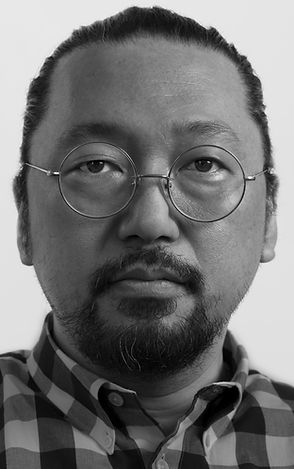exhibitions
Featured Artist
Takashi Murakami 1962 -
Takashi Murakami was born and raised in Tokyo, Japan. From early on, he was an enthusiastic follower of animation and manga (Japanese comics), and aspired to one day work in the animation industry. He attended T.U.A Tokyo University of the Arts, originally seeking to acquire the drafting skills necessary to become an animator, but eventually majored in Nihonga, the ‘traditional’ style of Japanese painting that incorporates traditional Japanese artistic conventions, techniques and subjects. Though he would go on to earn a Ph.D. in Nihonga, he gradually became disillusioned with the field’s insular, highly political world and started to explore more contemporary artistic styles, media, and strategies.
Murakami has expressed a frustration with the lack of a reliable and sustainable art market in post-war Japan. Largely for this reason, he formulated a strategy wherein he would first establish himself in the Western art world and then import himself back to Japan, building a new type of art market in the process. In order to create something rooted in Japanese culture and history but still fresh and valid internationally, he began searching for something that could be considered ‘uniquely Japanese.’ After concluding that elements of ‘high’ art were confounding at best, he began to focus on Japan’s ‘low’ culture, especially anime and manga, and the larger subculture of otaku.
Murakami’s art encompasses a wide range of mediums and is generally described as Superflat. His work has been noted for its use of color, incorporation of motifs from Japanese traditional and popular culture, flat/glossy surfaces, and content that could be described at once as “cute,” “psychedelic,” or “satirical”. Among his most famous recurring motifs are smiling flowers, iconic characters, mushrooms, skulls, Buddhist iconography, and the sexual complexes of otaku culture.
Having earned success and recognition internationally, Murakami has devoted himself to nurturing and supporting the careers of a younger generation of Japanese artists through Kaikai Kiki Co., Ltd. Likening the operation to that of a record label, he offers both logistic support and practical career advice. Through this endeavor, he also seeks to build an original and sustainable art market in Japan.
In 2000, Murakami organized a paradigmatic exhibition of Japanese art titled “Superflat,” which traced the origins of contemporary Japanese visual pop culture in historical Japanese art. He has continued this work in subsequent impactful exhibitions such as "Coloriage" (Fondation Cartier pour l'art contemporain, Paris, 2002) and “Little Boy: The Art of Japan's Exploding Subcultures” (Japan Society, New York, 2005). In 2011, he organized the "New Day: Artists for Japan" international charity auction at Christie’s New York in response to the 2011 Tōhoku earthquake and tsunami. Murakami currently lives and works in Tokyo.
 |
|---|
 |
 |
 |
 |
 |
 |




